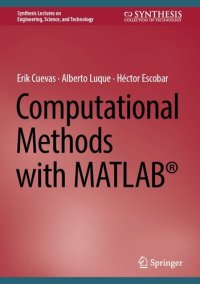
Ebook: Computational Methods with MATLAB
Author: Erik Cuevas, Alberto Luque, Héctor Escobar
- Genre: Computers // Software: Systems: scientific computing
- Series: Synthesis Lectures on Engineering Science and Technology
- Year: 2023
- Publisher: Springer Nature Switzerland
- Language: English
- epub
The objective of this book is to present a comprehensive and consistent overview of numerical methods for undergraduate students and professionals in the engineering field. The book can also serve as a reference for engineering professionals who have the need to use MATLAB in their applications. This is because many of the MATLAB codes, presented after introducing the basic ideas of each algorithm, can be easily modified to solve similar problems even by those who do not know what goes on inside MATLAB routines and the algorithms they use.
This book can be successfully used by two types of readers. The first type are those readers who require a detailed explanation of each algorithm and its potential. These readers are interested in knowing each method in such a way that they can modify the structure and make adaptations to solve their problems. The second are those readers who want to use numerical methods generically as subroutines. Just as most users of a household appliance need only know how to operate it to perform a task, these users need only know how to formulate their problems that they want to solve using MATLAB and how to use the corresponding routines to solve them. It is important to clarify that detailed knowledge of the numerical method is useful for finding a solution to a particular engineering problem. However, it is only implied that one-time users of any numerical method can use this book, as well as readers who want to understand the underlying principle/equations of each algorithm.
This book focuses primarily on helping readers understand the fundamental mathematical concepts of numerical methods and practice problem-solving skills using MATLAB. The methodology of the book is to first teach basic concepts so that readers can correctly formulate problems mathematically, skipping some tedious and unnecessary checks. Then, readers can directly implement the codes in MATLAB to solve practical problems. All algorithms presented in this book are followed by a MATLAB code example so that students can easily modify the code to solve their own problems. This methodology is grounded in the belief that the majority of students and professionals, especially those with backgrounds outside of mathematics, recognize the paramount significance of effectively employing numerical tools to address their pertinent challenges. This practical application holds greater importance than considering only extensive demonstrations and proofs.
The book uses much more code than formal mathematics. This is because we are convinced that even readers with an excellent mathematical background have trouble understanding an approach until they see the algorithm implemented in code. This fact is because the implemented code removes all ambiguities.
This book can be successfully used by two types of readers. The first type are those readers who require a detailed explanation of each algorithm and its potential. These readers are interested in knowing each method in such a way that they can modify the structure and make adaptations to solve their problems. The second are those readers who want to use numerical methods generically as subroutines. Just as most users of a household appliance need only know how to operate it to perform a task, these users need only know how to formulate their problems that they want to solve using MATLAB and how to use the corresponding routines to solve them. It is important to clarify that detailed knowledge of the numerical method is useful for finding a solution to a particular engineering problem. However, it is only implied that one-time users of any numerical method can use this book, as well as readers who want to understand the underlying principle/equations of each algorithm.
This book focuses primarily on helping readers understand the fundamental mathematical concepts of numerical methods and practice problem-solving skills using MATLAB. The methodology of the book is to first teach basic concepts so that readers can correctly formulate problems mathematically, skipping some tedious and unnecessary checks. Then, readers can directly implement the codes in MATLAB to solve practical problems. All algorithms presented in this book are followed by a MATLAB code example so that students can easily modify the code to solve their own problems. This methodology is grounded in the belief that the majority of students and professionals, especially those with backgrounds outside of mathematics, recognize the paramount significance of effectively employing numerical tools to address their pertinent challenges. This practical application holds greater importance than considering only extensive demonstrations and proofs.
The book uses much more code than formal mathematics. This is because we are convinced that even readers with an excellent mathematical background have trouble understanding an approach until they see the algorithm implemented in code. This fact is because the implemented code removes all ambiguities.
Download the book Computational Methods with MATLAB for free or read online
Continue reading on any device:

Last viewed books
Related books
{related-news}
Comments (0)